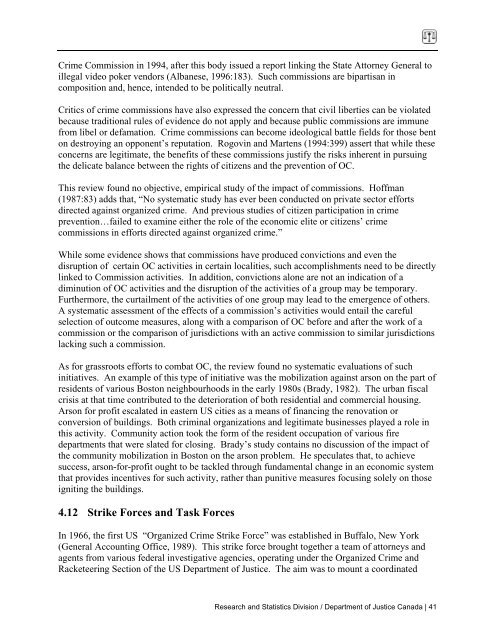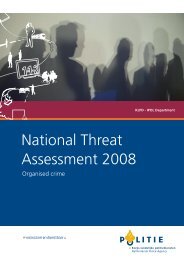Assessing the Effectiveness of Organized Crime Control Strategies ...
Assessing the Effectiveness of Organized Crime Control Strategies ...
Assessing the Effectiveness of Organized Crime Control Strategies ...
Create successful ePaper yourself
Turn your PDF publications into a flip-book with our unique Google optimized e-Paper software.
<strong>Crime</strong> Commission in 1994, after this body issued a report linking <strong>the</strong> State Attorney General to<br />
illegal video poker vendors (Albanese, 1996:183). Such commissions are bipartisan in<br />
composition and, hence, intended to be politically neutral.<br />
Critics <strong>of</strong> crime commissions have also expressed <strong>the</strong> concern that civil liberties can be violated<br />
because traditional rules <strong>of</strong> evidence do not apply and because public commissions are immune<br />
from libel or defamation. <strong>Crime</strong> commissions can become ideological battle fields for those bent<br />
on destroying an opponent’s reputation. Rogovin and Martens (1994:399) assert that while <strong>the</strong>se<br />
concerns are legitimate, <strong>the</strong> benefits <strong>of</strong> <strong>the</strong>se commissions justify <strong>the</strong> risks inherent in pursuing<br />
<strong>the</strong> delicate balance between <strong>the</strong> rights <strong>of</strong> citizens and <strong>the</strong> prevention <strong>of</strong> OC.<br />
This review found no objective, empirical study <strong>of</strong> <strong>the</strong> impact <strong>of</strong> commissions. H<strong>of</strong>fman<br />
(1987:83) adds that, “No systematic study has ever been conducted on private sector efforts<br />
directed against organized crime. And previous studies <strong>of</strong> citizen participation in crime<br />
prevention…failed to examine ei<strong>the</strong>r <strong>the</strong> role <strong>of</strong> <strong>the</strong> economic elite or citizens’ crime<br />
commissions in efforts directed against organized crime.”<br />
While some evidence shows that commissions have produced convictions and even <strong>the</strong><br />
disruption <strong>of</strong> certain OC activities in certain localities, such accomplishments need to be directly<br />
linked to Commission activities. In addition, convictions alone are not an indication <strong>of</strong> a<br />
diminution <strong>of</strong> OC activities and <strong>the</strong> disruption <strong>of</strong> <strong>the</strong> activities <strong>of</strong> a group may be temporary.<br />
Fur<strong>the</strong>rmore, <strong>the</strong> curtailment <strong>of</strong> <strong>the</strong> activities <strong>of</strong> one group may lead to <strong>the</strong> emergence <strong>of</strong> o<strong>the</strong>rs.<br />
A systematic assessment <strong>of</strong> <strong>the</strong> effects <strong>of</strong> a commission’s activities would entail <strong>the</strong> careful<br />
selection <strong>of</strong> outcome measures, along with a comparison <strong>of</strong> OC before and after <strong>the</strong> work <strong>of</strong> a<br />
commission or <strong>the</strong> comparison <strong>of</strong> jurisdictions with an active commission to similar jurisdictions<br />
lacking such a commission.<br />
As for grassroots efforts to combat OC, <strong>the</strong> review found no systematic evaluations <strong>of</strong> such<br />
initiatives. An example <strong>of</strong> this type <strong>of</strong> initiative was <strong>the</strong> mobilization against arson on <strong>the</strong> part <strong>of</strong><br />
residents <strong>of</strong> various Boston neighbourhoods in <strong>the</strong> early 1980s (Brady, 1982). The urban fiscal<br />
crisis at that time contributed to <strong>the</strong> deterioration <strong>of</strong> both residential and commercial housing.<br />
Arson for pr<strong>of</strong>it escalated in eastern US cities as a means <strong>of</strong> financing <strong>the</strong> renovation or<br />
conversion <strong>of</strong> buildings. Both criminal organizations and legitimate businesses played a role in<br />
this activity. Community action took <strong>the</strong> form <strong>of</strong> <strong>the</strong> resident occupation <strong>of</strong> various fire<br />
departments that were slated for closing. Brady’s study contains no discussion <strong>of</strong> <strong>the</strong> impact <strong>of</strong><br />
<strong>the</strong> community mobilization in Boston on <strong>the</strong> arson problem. He speculates that, to achieve<br />
success, arson-for-pr<strong>of</strong>it ought to be tackled through fundamental change in an economic system<br />
that provides incentives for such activity, ra<strong>the</strong>r than punitive measures focusing solely on those<br />
igniting <strong>the</strong> buildings.<br />
4.12 Strike Forces and Task Forces<br />
In 1966, <strong>the</strong> first US “<strong>Organized</strong> <strong>Crime</strong> Strike Force” was established in Buffalo, New York<br />
(General Accounting Office, 1989). This strike force brought toge<strong>the</strong>r a team <strong>of</strong> attorneys and<br />
agents from various federal investigative agencies, operating under <strong>the</strong> <strong>Organized</strong> <strong>Crime</strong> and<br />
Racketeering Section <strong>of</strong> <strong>the</strong> US Department <strong>of</strong> Justice. The aim was to mount a coordinated<br />
Research and Statistics Division / Department <strong>of</strong> Justice Canada | 41








